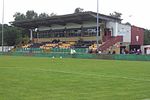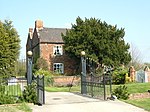Minworth
Minworth is a suburban village situated in the civil parish of Sutton Coldfield, West Midlands. It lies within the City of Birmingham on its northeastern outer fringe, where it forms part of the Sutton Walmley and Minworth electoral ward and borders the North Warwickshire district, some 4.5 miles southeast of Sutton Coldfield town centre. The village is immediately adjacent to the Sutton suburb of Walmley, the hamlet of Wiggins Hill and the Warwickshire village of Curdworth. The River Tame runs through the south of the area. Minworth has close transport links to the M6, M6 Toll and M42 motorways, while the closest rail station is nearby Water Orton railway station in Water Orton, Warwickshire.
Excerpt from the Wikipedia article Minworth (License: CC BY-SA 3.0, Authors).Minworth
Robinson Way, Birmingham
Geographical coordinates (GPS) Address Nearby Places Show on map
Geographical coordinates (GPS)
| Latitude | Longitude |
|---|---|
| N 52.526887 ° | E -1.7678049 ° |
Address
Robinson Way
Robinson Way
B76 9BB Birmingham
England, United Kingdom
Open on Google Maps






